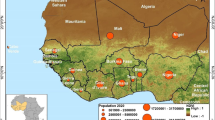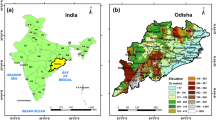Abstract
Malaria is a vector-borne disease, likely to be affected by climate change. In this study, general circulation model (GCM)-based scenarios were used for projecting future climate patterns and malaria incidence by artificial neural networks (ANN) in Zahedan district, Iran. Daily malaria incidence data of Zahedan district from 2000 to 2019 were inquired. The gamma test was used to select the appropriate combination of parameters for nonlinear modeling. The future climate pattern projections were obtained from HadGEM2-ES. The output was downscaled using LARS-WG stochastic weather generator under two Representative Concentration Pathway (RCP2.6 and RCP8.5) scenarios. The effect of climate change on malaria transmission for 2021–2060 was simulated by ANN. The designed model indicated that the future climate in Zahedan district will be warmer, more humid, and with more precipitation. Assessment of the potential impact of climate change on the incidence of malaria by ANN showed the number of malaria cases in Zahedan under both scenarios (RCP2.6 and RCP 8.5). It should be noted that due to the lack of daily malaria data before 2013, monthly data from 2000 were used only for initial analysis; and in preprocessing and simulation analyses, the daily malaria data from 2013 to 2019 were used. Therefore, if proper interventions are not implemented, malaria will continue to be a health issue in this region.









Similar content being viewed by others
Notes
Normalized root mean square error.
Normalized mean absolute error.
References
Abdullah S et al (2016) Malaria and blood transfusion: major issues of blood safety in malaria-endemic countries and strategies for mitigating the risk of Plasmodium parasites. Parasitol Res 115(1):35–47
Alonso D et al (2011) Epidemic malaria and warmer temperatures in recent decades in an East African highland. Proc R Soc b: Biol Sci 278(1712):1661–1669
Asadgol Z et al (2019) The effect of climate change on cholera disease: the road ahead using artificial neural network. PLoS ONE 14(11):e0224813
Badirzadeh A et al (2016) Burden of malaria in Iran, 1990–2010: findings from the Global Burden of Disease Study 2010. Arch Iran Med 19(4):241–247
Barros VR et al (2017) Climate change 2014: impacts, adaptation, and vulnerability. Part A: Global and Sectoral Aspects. Contribution of Working Group II to the Fifth Assessment Report of the Intergovernmental Panel on Climate Change, CB Field and others (eds.), Cambridge, Cambridge University Press
Baxter P et al (2001) Health effects of climate change in the UK: an expert review for comment. London: Department of Health: 177–187.
Caminade C et al (2014) Impact of climate change on global malaria distribution. Proc Natl Acad Sci 111(9):3286–3291
Chaturvedi S et al (2021) Understanding the effect of climate change in the distribution and intensity of malaria transmission over India using a dynamical malaria model. Int J Biometeorol: 1–15
Chaves LF et al (2010) Climate change and highland malaria: fresh air for a hot debate. Q Rev Biol 85(1):27–55
Chemison A et al (2021) Impact of an accelerated melting of Greenland on malaria distribution over Africa. Nat Commun 12(1):1–12
Chisanga CB et al (2017) Statistical downscaling of precipitation and temperature using long ashton research station weather generator in Zambia: a case of mount makulu agriculture research station. Am J Clim Chang 6(03):487
Cottrell G et al (2012) Modeling the influence of local environmental factors on malaria transmission in Benin and its implications for cohort study. PLoS ONE 7(1):e28812
Craig M et al (2004) Exploring 30 years of malaria case data in KwaZulu-Natal, South Africa: part I. The impact of climatic factors. Tropical Med Int Health 9(12):1247–1257
Dhiman S (2019) Are malaria elimination efforts on right track? An analysis of gains achieved and challenges ahead. Infect Dis Poverty 8:14. https://doi.org/10.1186/s40249-019-0524-x
Ebi KL et al (2005) Climate suitability for stable malaria transmission in Zimbabwe under different climate change scenarios. Clim Change 73(3):375
Eikenberry SE et al (2018) Mathematical modeling of climate change and malaria transmission dynamics: a historical review. J Math Biol 77(4):857–933
Epstein PR (2001) Climate change and emerging infectious diseases. Microbes Infect 3(9):747–754
Esmaeelnejad L et al (2015) Selection of a suitable model for the prediction of soil water content in north of Iran. Span J Agric Res 13(1):1202
Field CB (2014) Climate change 2014–impacts, adaptation and vulnerability: regional aspects. Cambridge University Press
Guerra CA et al (2010) The international limits and population at risk of Plasmodium vivax transmission in 2009. PLoS Negl Trop Dis 4(8):e774
Hay SI et al (1998) Predicting malaria seasons in Kenya using multitemporal meteorological satellite sensor data. Trans R Soc Trop Med Hyg 92(1):12–20
Houshyar M et al (2018) Future projection of Maximum Temperature in Urmia through Downscaling output of CanESM2 Model. Geography and Planning 22(63):305–325
Kabood SHT et al (2020) Investigating the effects of climate change on stream flows of Urmia Lake basin in Iran. Model Earth Sys Environ 6(1):329–339
Kelly-Hope LA et al (2009) Environmental factors associated with the malaria vectors Anopheles gambiae and Anopheles funestus in Kenya. Malar J 8(1):268
Kim Y-M et al (2012) Estimated effect of climatic variables on the transmission of Plasmodium vivax malaria in the Republic of Korea. Environ Health Perspect 120(9):1314–1319
Le PV et al (2019) Predicting the direct and indirect impacts of climate change on malaria in coastal Kenya. PLoS ONE 14(2):e0211258
Masson-Delmotte V et al (2018) IPCC, 2018: summary for policymakers. 1
McCord GC (2016) Malaria ecology and climate change. European Phys J Spec Top 225(3):459–470
Mirahmadi H et al (2020) Retrospective epidemiological study of malaria from 1999 to 2016 in Khash, Iran: a region on the verge of malaria elimination
Mohammadkhani M et al (2016) The relation between climatic factors and malaria incidence in Kerman, South East of Iran. Parasite Epidemiol Control 1(3):205–210
Mohammadkhani M et al (2019) The relation between climatic factors and malaria incidence in Sistan and Baluchestan, Iran. SAGE Open 9(3):2158244019864205
Mosawi SH et al (2020) Evaluation of asymptomatic malaria status in Eastern of Afghanistan using high resolution melting analysis. Iran J Parasitol 15(2):177
Nasr-Azadani F et al (2015) Downscaling river discharge to assess the effects of climate change on cholera outbreaks in the Bengal Delta. Climate Res 64(3):257–274
O’Brien SF et al (2015) The epidemiology of imported malaria and transfusion policy in 5 nonendemic countries. Transfus Med Rev 29(3):162–171
Omer SM et al (1970) Survival of female Anopheles gambiae Giles through a 9-month dry season in Sudan. Bull World Health Organ 42(2):319
Paaijmans KP et al (2010) Relevant microclimate for determining the development rate of malaria mosquitoes and possible implications of climate change. Malar J 9(1):196
Parhizgari N et al (2021) Vector-borne diseases in Iran: epidemiology and key challenges. Future Microbiol 16:51–69
Piri J et al (2009) Daily pan evaporation modeling in a hot and dry climate. J Hydrol Eng 14(8):803–811
Piroozi B et al (2019) Incidence, mortality, and burden of malaria and its geographical distribution in Iran during 2002–2015. Iran J Public Health 48((Supple 1)):53–61
Purse BV et al (2017) How will climate change pathways and mitigation options alter incidence of vector-borne diseases? A framework for leishmaniasis in South and Meso-America. PLoS ONE 12(10):e0183583
Rogers D et al (2006) Climate change and vector-borne diseases. Adv Parasitol 62:345–381
Rossati A et al (2016) Climate, environment and transmission of malaria. Infez Med 24(2):93–104
Ryan SJ et al (2020) Shifting transmission risk for malaria in Africa with climate change: a framework for planning and intervention. Malar J 19(1):1–14
Semakula HM et al (2017) Prediction of future malaria hotspots under climate change in sub-Saharan Africa. Clim Change 143(3):415–428
Semenov MA et al (2010) Use of multi-model ensembles from global climate models for assessment of climate change impacts. Climate Res 41(1):1–14
Semenov MA et al (2002) A stochastic weather generator for use in climate impact studies. User Man Herts UK
Sharma VP (2002) Determinants of malaria in South Asia. The contextual determinants of malaria: 110–132
Soofi K et al (2019) The challenges of the malaria elimination program in the South East of Iran: a qualitative study. J Arthropod Borne Dis 13(1):94
Suh E et al (2020) The influence of feeding behaviour and temperature on the capacity of mosquitoes to transmit malaria. Nat Ecol Evol 4(7):940–951
Tanser FC et al (2003) Potential effect of climate change on malaria transmission in Africa. Lancet 362(9398):1792–1798
Weber EU (2006) Experience-based and description-based perceptions of long-term risk: why global warming does not scare us (yet). Clim Change 77(1–2):103–120
World Health Organization (2021) World malaria report 2021, World Health Organization
Wu W et al (2015) Comparison of two hybrid models for forecasting the incidence of hemorrhagic fever with renal syndrome in Jiangsu Province, China. PLoS ONE 10(8):e0135492
Yamana TK et al (2013) Projected impacts of climate change on environmental suitability for malaria transmission in West Africa. Environ Health Perspect 121(10):1179–1186
Yang E et al (2018) A simulation-based study on the comparison of statistical and time series forecasting methods for early detection of infectious disease outbreaks. Int J Environ Res Public Health 15(5):966
Yé Y et al (2007) Effect of meteorological factors on clinical malaria risk among children: an assessment using village-based meteorological stations and community-based parasitological survey. BMC Public Health 7(1):101
Zhou SS et al (2010) Geographical, meteorological and vectorial factors related to malaria re-emergence in Huang-Huai River of central China. Malar J 9(1):1–9
Zubaidi SL et al (2018) A Novel approach for predicting monthly water demand by combining singular spectrum analysis with neural networks. J Hydrol 561:136–145
Zubaidi SL et al (2020) Hybridised artificial neural network model with slime mould algorithm: a novel methodology for prediction of urban stochastic water demand. Water 12(10):2692
Acknowledgements
The authors would like to express sincere thanks to Deputy of Health of Sistan-Baluchistan University of Medical Science and the Meteorological Organization of Iran (IRIMO).
Funding
This work was supported by Kerman University of Medical Sciences, Kerman, Iran (grant no. 9900307).
Author information
Authors and Affiliations
Corresponding author
Additional information
Publisher’s note
Springer Nature remains neutral with regard to jurisdictional claims in published maps and institutional affiliations.
Rights and permissions
About this article
Cite this article
Nili, S., Asadgol, Z., Dalaei, H. et al. The effect of climate change on malaria transmission in the southeast of Iran. Int J Biometeorol 66, 1613–1626 (2022). https://doi.org/10.1007/s00484-022-02305-2
Received:
Revised:
Accepted:
Published:
Issue Date:
DOI: https://doi.org/10.1007/s00484-022-02305-2




